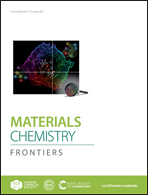New shoots from old roots: multiple stimuli-responsive properties of a common tetraphenylethene derivative†
Abstract
Multiple stimuli-responsive fluorescent materials are still in high demand owing to their academic significance and potential applications. Designing a novel molecule with multiple stimuli-responsive properties is difficult due to the deficiency of an effective design strategy. Herein, a feasible route to achieve this goal is presented, which is screening of stimuli-responsive properties (new shoots) of reported compounds (old roots). Compound 1, a well-known tetraphenylethene intermediate, was discovered to possess reversible tricolored mechanochromism (MC) and recyclable mechanoluminescence (ML) properties. Under different external stimuli, 1 exhibited three reversible fluorescence states (blue, cyan and green) according to the transition of different packing modes, which could be utilized to realize optical recording and anti-counterfeiting applications. Moreover, the ML of compound 1 could realize in situ recovery and recycling by thermal treatment. It is worth noting that for most of the reported materials it was difficult to realize completely reversible tricolored MC or recyclable ML properties. This rediscovered example should be useful for further development of multiple stimuli-responsive materials.



 Please wait while we load your content...
Please wait while we load your content...